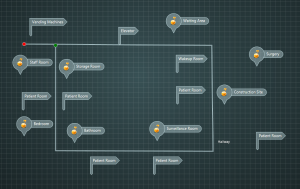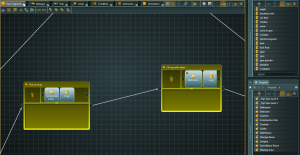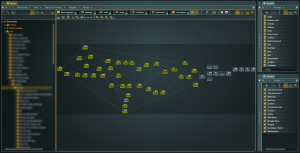
Adventures need puzzles. And good ones actually. When I think of adventure puzzles the following categories come to my mind:
Item-Based
You collect some item, use it somewhere else, combine items to create new items and use these etc. For me that is THE basis of an adventure game. There is a trend these days to minimize that part, have only one click actions, use items automatically, simplify it more and more so that in the end you have more of an interactive movie than a game (I am looking at you, Telltale!). I loved The Walking Dead, but it did not pose a real challenge, just the story was interesting and kept me going.
I want to go for more items again while still having an awesome story. Why not combine the best of both?
Puzzle-Based
This is something I really did not understand for quite a while. In a game you would walk for example through an empty house and find strange objects. Let’s say a checker board. You need to find the missing checker piece and suddenly a door opens. Oh come on. Really? For me these are interesting puzzles put into the totally wrong context.
Dialog-Based
Remember the Monkey Island becoming-a-pirate challenge? You had to sword fight and could only win choosing appropriate swear word dialog options. I loved those.
Time-Based
For those you trigger an action which then in turn gives you time to do one other action, e.g. you disturb a security guard so that he is briefly not looking and in that time you can do something else. It goes a bit against the flow of traditional adventures where you have all the time in the world but I feel it can generate a spike in player interest every now and then if there is a sense of urgency.
Activity-Based
Here I see things like quick-time actions, moving along a path/set of way points etc. I really like these elements as they get the player more involved into the story and make them feel with the hero.
My Approach
Designing good puzzles is quite hard I think. I start out with a location that I have from my story and then picture the flow of the story inside that location. Then I think of obstacles and problems that could arise in that location that fit to the story. More often than I wish I deleted ideas because they felt either stupid or too artificially constructed. Ironically I still have one puzzle chain in that is a bit weird but it also raises the difficulty a bit because of that so I keep it.
I started out with Notepad to scribble down ideas but then realized that this does not work at all for me. Puzzles have prerequisites, they enable other puzzles, items can be combined etc. I played with Mindmaps shortly but luckily found a tool that fits much better: Articy Draft. I got it during a Steam Sale and could not be happier.
 I start out with a top-down map of the level. I create location entries for each room. On the right you see the map for my hospital level. It’s super rudimentary but fulfills the need. This gives me a sense for the space that I must cover when modelling. It also helps to decide if there are too many or too few rooms.
I start out with a top-down map of the level. I create location entries for each room. On the right you see the map for my hospital level. It’s super rudimentary but fulfills the need. This gives me a sense for the space that I must cover when modelling. It also helps to decide if there are too many or too few rooms.
 Then I switch to the flow view where I have one flow for each level and inside the flow I have sub-flows for the puzzles. I create items and then start with the flow by putting fragments on there and then an item and location marker into the fragments.
Then I switch to the flow view where I have one flow for each level and inside the flow I have sub-flows for the puzzles. I create items and then start with the flow by putting fragments on there and then an item and location marker into the fragments.
 I then connect all items with their prerequisite items and their follow-ups and get a nice map. From that I get lots of information: are all items used, are they all connected (single start of the level, single end, no unintentional dead ends), are they spread out nicely so that I can put story elements/turning points evenly throughout and also are there multiple paths possible in parallel so that if a player does not find the solution to one puzzle he can still solve another one? I also color code the fragments. Blue means initial state, yellow: I have them coded in the game, green: I have polished them, finalized the item models/pictures and provided cut scenes etc.
I then connect all items with their prerequisite items and their follow-ups and get a nice map. From that I get lots of information: are all items used, are they all connected (single start of the level, single end, no unintentional dead ends), are they spread out nicely so that I can put story elements/turning points evenly throughout and also are there multiple paths possible in parallel so that if a player does not find the solution to one puzzle he can still solve another one? I also color code the fragments. Blue means initial state, yellow: I have them coded in the game, green: I have polished them, finalized the item models/pictures and provided cut scenes etc.
As you can see I nearly finished all puzzles and flows! How awesome is that. I even have a first test for quick-time events. Really looking forward to my first complete play-through and then I can start polishing by providing more believable scenery, characters, dialogs and cut-scenes. But even without these the game should be fun. That is my goal.